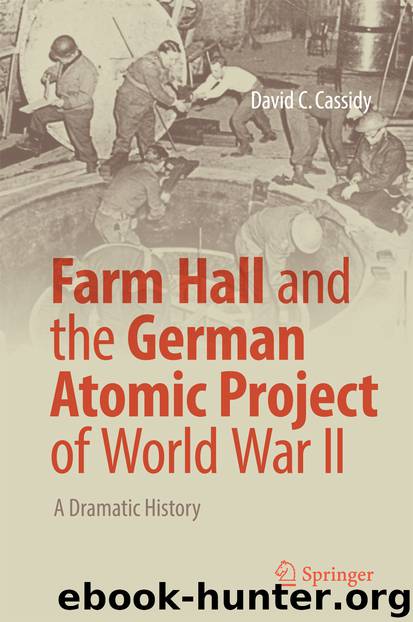Farm Hall and the German Atomic Project of World War II by David C. Cassidy

Author:David C. Cassidy
Language: eng
Format: epub
Publisher: Springer International Publishing, Cham
As the Allied bombing campaign mounted over Germany, Heisenberg’s uranium did not arrive until nearly a year later. Now fully exonerated and the fission project safely underway as a demonstration to friend and foe alike of the utility of nuclear research and the continued viability of German physics, Heisenberg used the hiatus in his nuclear engineering work to pursue his primary interest, theoretical quantum physics. He began submitting a series of theoretical physics papers for publication in a German journal on the scattering of high-energy elementary particles. These led to his well-known S-matrix theory of particle scattering, which enjoyed considerable international interest after the war.
During this same period Bagge in Berlin and Clusius in Munich pursued various methods for separating the fissionable isotope U-235, but with little success. Not so Diebner. After his uranium cubes finally arrived, Diebner made remarkable progress with his design, obtaining neutron multiplication far greater than Heisenberg’s Leipzig group had ever achieved. By that time the army had withdrawn entirely from nuclear research, and his project was under the auspices of the Reich Bureau of Standards. When it soon came under the oversight of nuclear administrator Walther Gerlach, Gerlach began shifting Research Council funds to Diebner’s reactor, along with additional funds he managed to obtain from the SS. He allowed Diebner’s and Heisenberg’s projects to proceed simultaneously in the hope that at least one would succeed. He apparently overlooked the likelihood that the competition for scarce resources would prevent either from achieving success.
By the time the uranium plates arrived in Berlin, Heisenberg was ready to concede the superiority of Diebner’s design. But the Allied bombing raids had become so intense that during the summer of 1943 Speer ordered all research groups to begin vacating the city. As Heisenberg sent the plates back to Auer to be cut into cubes, nearly a third of his institute of 55 members fled Berlin for a vacant textile factory in the Swabian village of Hechingen nestled among the rolling hills of southwestern Germany near the Black Forest. Members of Otto Hahn’s institute for chemistry, now in ruins from the bombing, moved to the nearby town of Tailfingen. They were soon joined by Carl Friedrich von Weizsäcker who had escaped capture and the bombing of German-occupied Strasbourg in France, where he had accepted a professorship in theoretical physics. As the Allied bombing of German cities intensified, Heisenberg moved his wife and growing family of six children permanently to their summer cottage in Urfeld near the shore of Lake Walchen in Upper Bavaria, south of Munich.
Heisenberg and Wirtz bravely remained at their posts in Berlin through the end of 1944. They were in the midst of assembling their uranium and heavy water into a long-awaited reactor when Gerlach suddenly ordered them out of the city. The city was nearly under siege, with massive air raids from above and the Soviet Red Army rolling relentlessly westward toward Berlin. Gerlach arranged for Diebner and his equipment to join Heisenberg’s convoy of trucks south, but half way to Hechingen Gerlach had second thoughts.
Download
This site does not store any files on its server. We only index and link to content provided by other sites. Please contact the content providers to delete copyright contents if any and email us, we'll remove relevant links or contents immediately.
The Complete Stick Figure Physics Tutorials by Allen Sarah(7336)
Secrets of Antigravity Propulsion: Tesla, UFOs, and Classified Aerospace Technology by Ph.D. Paul A. Laviolette(5332)
Thing Explainer by Randall Munroe(3909)
The River of Consciousness by Oliver Sacks(3572)
The Order of Time by Carlo Rovelli(3162)
How To by Randall Munroe(3074)
A Brief History of Time by Stephen Hawking(2991)
I Live in the Future & Here's How It Works by Nick Bilton(2959)
What If?: Serious Scientific Answers to Absurd Hypothetical Questions by Randall Munroe(2667)
The Great Unknown by Marcus du Sautoy(2662)
Midnight in Chernobyl by Adam Higginbotham(2515)
Blockchain: Ultimate Step By Step Guide To Understanding Blockchain Technology, Bitcoin Creation, and the future of Money (Novice to Expert) by Keizer Söze(2467)
Networks: An Introduction by Newman Mark(2382)
The Meaning of it All by Richard Feynman(2318)
Easy Electronics by Charles Platt(2308)
The Tao of Physics by Fritjof Capra(2247)
Midnight in Chernobyl: The Untold Story of the World's Greatest Nuclear Disaster by Adam Higginbotham(2195)
When by Daniel H Pink(2098)
Introducing Relativity by Bruce Bassett(2097)
